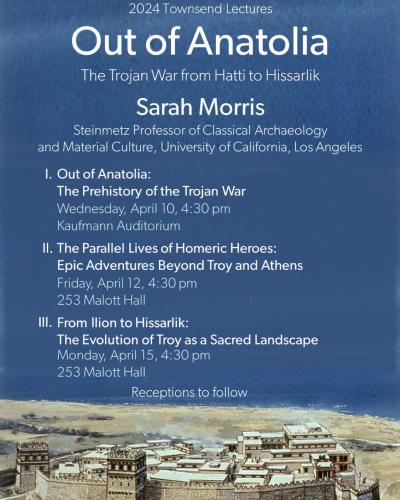Scientific research often depends on a degree of certainty in the data while allowing for the likelihood of change – new findings overriding old theories and creating new ones. Change is a given, especially true when taking weather and climate into account.
Archaeologist Sturt Manning and colleagues have revealed variations in the radiocarbon cycle at certain periods of time, affecting frequently cited standards used in archaeological and historical research relevant to the southern Levant region (Israel, southern Jordan and Egypt). These variations, or offsets, of up to 20 years in the calibration of precise radiocarbon dating could be related to climatic conditions.
Manning, the Goldwin Smith Professor of Classical Archaeology in the Department of Classics and director of the Cornell Tree-Ring Laboratory, is the lead author of “Fluctuating Radiocarbon Offsets Observed in the Southern Levant and Implications for Archaeological Chronology Debates,” published May 29 in the Proceedings of the National Academy of Sciences.
Pre-modern radiocarbon chronologies rely on standardized Northern and Southern Hemisphere calibration curves to obtain calendar dates from organic material. (The current Northern Hemisphere standard is IntCal13, published in 2013.) These standard calibration curves assume that at any given time radiocarbon levels are similar and stable everywhere across each hemisphere.
The Cornell-led team had questions and suspicions.
“We went looking to test the assumption behind the whole field of radiocarbon dating,” Manning said. “We know from atmospheric measurements over the last 50 years that radiocarbon levels vary through the year, and we also know that plants typically grow at different times in different parts of the Northern Hemisphere. So we wondered whether the radiocarbon levels relevant to dating organic material might also vary for different areas and whether this might affect archaeological dating.”
Some research has “suggested there might be regional differences in radiocarbon levels, and hence problems for the standard model,” he said. “We set out to … see if we could observe such differences over time, and whether [they] were relevant to archaeological dating. If the existing assumed dates were to change, then you might discover a more complicated story, which is what we found – an unrecognized but visible complication that affects the radiocarbon standard used up to now for the southern Levant region. This finding changes dates at certain periods in the past, which affects the history we write.”
The authors measured a series of carbon-14 ages in southern Jordan tree rings, with established calendar dates between 1610 and 1940 A.D. They found that contemporary plant material growing in the southern Levant shows an average offset in radiocarbon age of about 19 years compared with IntCal13.
Manning noted that “scholars working on the early Iron Age and Biblical chronology in Jordan and Israel are doing sophisticated projects with radiocarbon age analysis, which argue for very precise findings. This then becomes the timeline of history. But our work indicates that it’s arguable their fundamental basis is faulty – they are using a calibration curve that is not accurate for this region.”
The standard IntCal13 curve is constructed from measurements of radiocarbon levels in trees from Central and Northern Europe and North America. Comparing his team’s results against IntCal13, “trees growing in southern Jordan are showing a different amount of radiocarbon compared with trees in central and northern Europe, and in North America,” Manning said.
“IntCal13 offers a pretty good guide to mid-latitude areas of the Northern Hemisphere but not, we discover, for other regions like the southern Levant. This affects the timeline of the past in these areas.”
Apparent fluctuations in the offset through time may be a consequence of climatic changes, periods of warming and cooling modulating the local growing seasons, the researchers say.
“These variations seem to relate to changes in regional climate, which likely see growing seasons move a little earlier or later,” Manning said. “For example, we see larger offsets [in the periods] 1685-1762 A.D. and 1818-1912 A.D., and these seem to link with generally warming conditions in the southern Levant.”
Applying their results to previously published chronologies, the researchers also show how even the relatively small offsets they observe can shift calendar dates by enough to alter ongoing archaeological, historical and paleoclimate debates.
“We have only investigated tree-rings from A.D. 1610-1940 so far, but we can reasonably assume that a similar pattern of radiocarbon fluctuations occurred in the centuries before for this region,” said Manning, who has published extensive research on radiocarbon and tree-ring chronologies, and has written about and taught courses on climate change through history. “There has been much debate for several decades among scholars arguing for different chronologies sometimes only decades to a century apart – each with major historical implications. And yet these studies … may all be inaccurate since they are using the wrong radiocarbon information.”
“Our work,” he added, “should prompt a round of revisions and rethinking for the timeline of the archaeology and early history of the southern Levant through the early Biblical period.”
His co-authors on the PNAS paper are Cornell Tree-Ring Laboratory senior researcher Carol Griggs ’77, Ph.D. ’06, and postdoctoral researcher Brita Lorentzen ’06, Ph.D. ’15; Christopher Bronk Ramsey and David Chivall of the Oxford University School of Archaeology; and A.J. Timothy Jull and Todd E. Lange of the University of Arizona’s Accelerator Mass Spectrometry Laboratory.
This story also appeared in the Cornell Chronicle.





